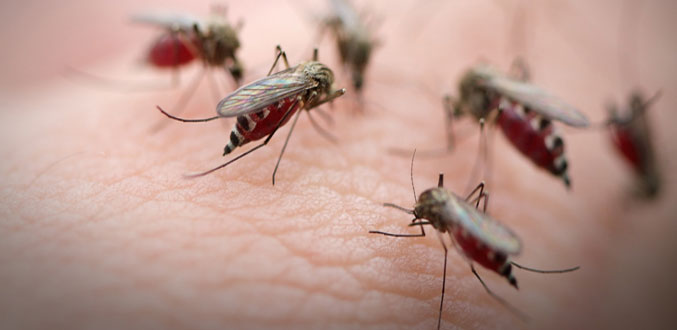May 31, 2025 08:56 pm (IST)

World Malaria Day: UN seeks near zero preventable deaths
New York, Apr 26 (IBNS): The tide has turned on malaria, with mortality rates for children in Africa down by half, but a stronger surveillance system is urgently needed to prevent new outbreaks and resurgences, United Nations officials on Friday warned, marking the sixth annual World Malaria Day.
“We must stay focused until the job is done,” said Ray Chambers, UN Special Envoy for Malaria. “The world has an ethical obligation to continue to protect the hundreds of millions of children who have slept safely under a bed net and who have had access to treatment.”
Child deaths from malaria declined from one million in 2008 to under 500,000 thanks to a community of malaria supporters who delivered nearly 44 million long-lasting mosquito nets in the first-quarters of this year alone, Chambers said.
“We have arrived at this historic moment thanks to the dedicated leaders of endemic countries; committed donor countries and organizations,” he added, including the UN-backed Global Fund to Fight AIDS, Tuberculosis and Malaria, the World Bank, and national Governments.
However, the disease killed an estimated 627,000 people in 2012, mostly children under the age of five in sub-Saharan Africa, according to figures cited by the UN. More than 200 million cases are believed to occur each year, most of them never tested or registered.
In his remarks on the Day, UN Secretary-General Ban Ki-moon said: “While we applaud progress to date, we must confront the fact that malaria still kills more than half a million people every year. Too many cases still go untested, unregistered and untreated.”
As such, the UN chief repeated his call for continued investment and sustained political commitment, and will to improve malaria prevention and control.
“We need more funding to maintain progress and continue scaling up coverage of effective malaria interventions,” he said, also calling for more resources to develop and maintain effective surveillance programmes and to combat increasing mosquito resistance to insecticides and parasite resistance to antimalarial drugs.
This year’s World Malaria Day is marked as the international community is accelerating progress towards the anti-poverty targets known as the Millennium Development Goals (MDGs).
Part of the MDGs is the target of halving and reversing the incidence of malaria by 2015.
“Malaria is preventable and curable,” said UN General Assembly President John Ashe who is one of the key officials spearheading the push towards reaching the MDGs and creating a new sustainable development agenda.
“Our effort must be a global one,” he added. “We know what it takes to stop this disease, and now we must work to make that knowledge universal.”
This year, the UN World Health Organization (WHO) is launching a manual to help countries to assess the technical, operational and financial feasibility of moving towards malaria elimination.
WHO’s new guide, From malaria control to malaria elimination: a manual for elimination scenario planning , will provide these countries with a comprehensive framework to assess different scenarios and timelines for moving towards elimination, depending on programme coverage and funding availability.
“Increased political commitment and the expansion of global malaria investments have saved some 3.3 million lives since 2000,” says Dr Margaret Chan, Director-General at WHO. ”Countries where malaria remains endemic now want to build on this success.”
Since 2000, there has been a 42 per cent reduction in malaria mortality rates globally, and a 49 per cent decline in the WHO African Region. This progress has led some malaria-endemic countries, even those with historically high burdens of malaria, to start exploring the possibility of elimination.
But although many countries have the political will to commit to elimination, technical, operational and financial obstacles remain, particularly in countries that have a high disease burden.
The WHO manual will help countries assess what resources they need to reduce malaria transmission to very low levels, i.e. the point at which focused elimination programmes can start in earnest. It will also help them consider appropriate timelines and provide them with essential knowledge for long-term strategic planning for malaria programmes.
“This long-term view on malaria is critical: it is vital to plan for the period after elimination,” says Dr John Reeder, Director of WHO’s Global Malaria Programme. “If interventions are eased or abandoned, malaria transmission can re-establish relatively quickly in areas that are prone to the disease, leading to a resurgence in infections and deaths.”
(Diarrhoea, respiratory infections and malaria account for 60 per cent of known environmental health impacts in Africa. Photo: UNEP)
Support Our Journalism
We cannot do without you.. your contribution supports unbiased journalism
IBNS is not driven by any ism- not wokeism, not racism, not skewed secularism, not hyper right-wing or left liberal ideals, nor by any hardline religious beliefs or hyper nationalism. We want to serve you good old objective news, as they are. We do not judge or preach. We let people decide for themselves. We only try to present factual and well-sourced news.
Support objective journalism for a small contribution.
Latest Headlines
India's 'Tiger Man' Valmik Thapar dies after battling cancer
Sat, May 31 2025
India to receive ‘above normal’ showers in June, IMD raises monsoon forecast by 106%
Tue, May 27 2025
Hawaii's Kilauea Volcano erupts with 1,000-foot 'lava fountaining'
Mon, May 26 2025
Flight ops hit, several streets waterlogged as Delhi receives heavy overnight rains
Sun, May 25 2025
Indian Monsoon rains hit Kerala eight days before schedule
Sat, May 24 2025







